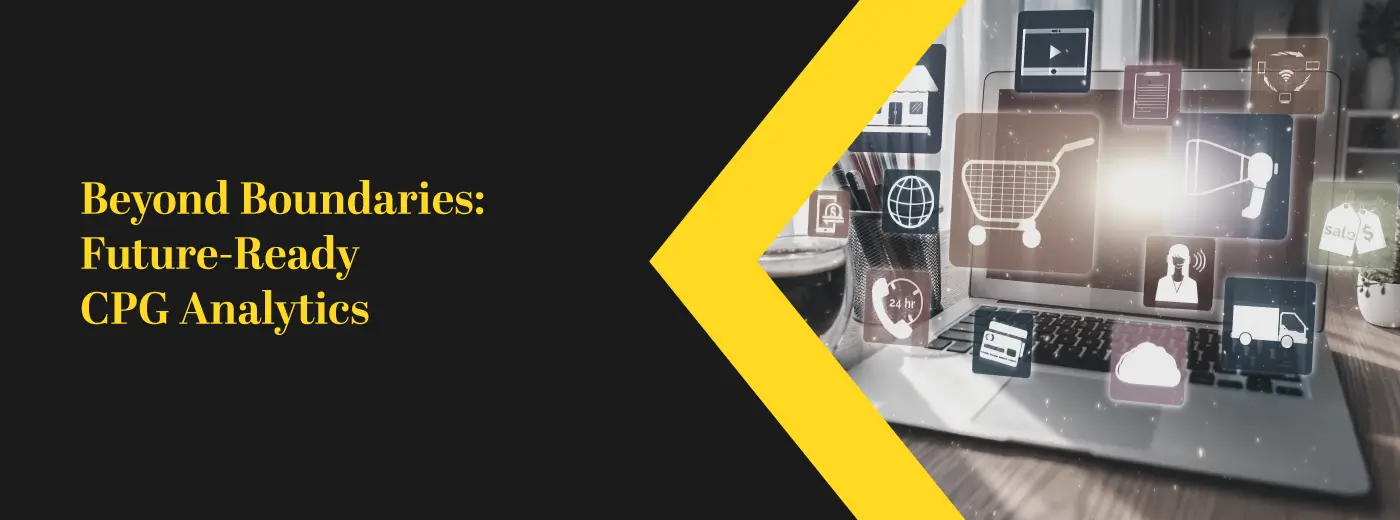
Sign up to receive latest insights & updates in technology, AI & data analytics, data science, & innovations from Polestar Analytics.
Editor's Note: In the era of exploding data and increasingly intricate purchasing decisions, the ever-evolving CPG industry presents a remarkable chance for companies to delve into consumer behavior and enhance their offerings, services, and marketing strategies. Join us on an enlightening exploration of the CPG industry's evolutionary journey where we uncover the driving forces behind this transformation and shed light on how CPG data analysis acts as a catalyst, fuelling growth and innovation. Get ready to tap into the boundless potential that lies within this dynamic landscape.
In the words of the ancient Greek philosopher Heraclitus:
"The world is an ever-changing river, and those who cling to the past will be swept away."
2022 had been a roller coaster ride for CPG brands. Between inflation, supply chain problems, and ever-changing consumer behaviour, a lot was going on. Now, as anticipated, it's evident that navigating the growth of CPG brands may prove to be quite challenging.
The current geo-political conflicts have changed the global consumer, retail, and supply markets. This change in behavior is expected to accelerate in the coming times. Consumers become more demanding and unpredictable, retailers struggle to keep up with the latest trends, and supply chains become increasingly complex, and businesses that fail to adapt will be left behind.
But fortunately, not everything on the horizon is looking bleak! While certain doors are closed, there are plenty of more opportunities that can facilitate substantial growth for CPG brands in the coming years.
The CPG market has witnessed significant growth in recent years despite the intense competition. In 2022, the market was valued at US$ 2060 billion in 2021, and it is anticipated to reach US$ 2808 billion by 2030, exhibiting a compound annual growth rate (CAGR) of 3.5%.

In the context of evolution, there has been substantial development in CPG, especially in the Sales and marketing space that has dramatically changed the face of CPG retail analytics.
In the last ten years, the Retail & Consumer Packaged Goods (CPG) industry has undergone substantial transformations in response to digital advancements, the advent of smartphones, and the widespread use of social media. CPG companies have started to move beyond traditional cardboard boxes and are actively exploring the potential of digital touchpoints to enhance the shopping experience for millennial consumers.
According to the report, jointly produced by The Boston Consulting Group, Google, and Information Resources Inc. (IRI) for the Grocery Manufacturer's Association, highlights the tipping point of digital media in the consumer-packaged goods industry.

The report, jointly produced by The Boston Consulting Group, Google, and Information Resources Inc. (IRI) for the Grocery Manufacturer's Association, highlights the tipping point of digital media in the consumer-packaged goods industry.
Reports highlight a "1-5-10" scenario, in which digital’s current 1 percent penetration most likely expands to 5 percent but could quickly accelerate to as much as 10 percent with breakthrough innovation in delivery models. However, penetration rates may vary in different locations and categories, sometimes substantially.
Some people can remember a time when milk, eggs, and butter were delivered to their homes every day. They might even recall seeing carts pulled by horses and filled with ice for delivering milk.
But things have changed. Nowadays, millions of people in major cities can get their groceries and household items delivered to their homes through services like AmazonFresh, FreshDirect, Google Shopping Express, and newer companies like Instacart. All these are the perfect example of CPG data insights and its analytics use cases.
Many others receive regular deliveries of essential items through online subscription services like Amazon's Subscribe & Save. Technology has improved how companies provide convenience, choice, and value, and it has raised our expectations for how things should be delivered.
For instance, during the initial stages of online commerce, 1-800-Flowers utilized its established position as a leader in phone-based flower orders, realizing that the digital platform could provide customers with an enhanced experience. The company made significant investments in digital content, revitalizing the process of shopping for flowers and contributing to the moment when the cut-flowers market reached a crucial turning point in the digital realm. Currently, the category enjoys a 15% online penetration rate and continues to expand.
For other categories like: -
In each of these segments, digital sales have witnessed a significant increase after reaching a tipping point, indicating that the industry successfully met consumer expectations with its digital offerings. These examples highlight the transformative power of technology in reshaping consumer behavior and expanding online sales in diverse product categories.
If we aim to summarize the viewpoint with a numbered list, three key points have emerged that have transformed the CPG data insights.
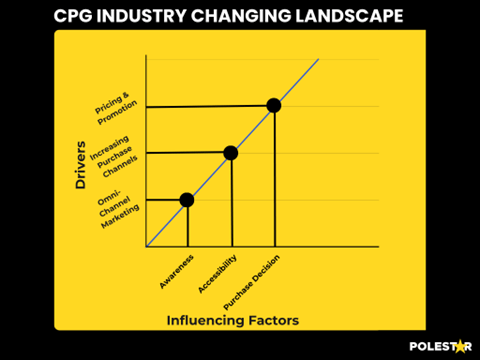
1. Volatility in demand due to increased consumer awareness: We must acknowledge the increased role of information and technology in how consumers make purchase decisions. Consumers today are a lot more aware. Different consumers intake information at separate times with varied impacts of information on purchase decisions. For example, consumer awareness and sensitivity to what is in the packaged goods they are purchasing and how it impacts Mother Earth have started to play a huge role in purchase decisions. Hence the arc of consumer awareness of adopting a sustainable lifestyle causes dramatic fluctuations in consumers' expectations from a brand which reflects in their buying choices.
2. The rapid increase in purchasing channels accessible to consumers: A customer is no longer tied to a Brick-and-Mortar store for purchases. With CPG data insights, purchasing decisions are being taken at home while commuting while working through different e-commerce services such as AmazonFresh, Fresh Direct, and Google Shopping Express. Moreover, the demand fulfillment expectations have also changed rapidly - which channels/stores to shop in and which products to purchase are consistently being defined by if the brand or store offers in-store shopping, BOPIS, DTC delivery, or other fulfillment requirements like delivery time.
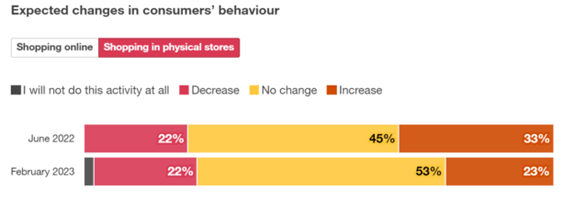

Source: PwC
3. Omni Channel Marketing: with cpg analytics solutions, consumer behavior has experienced a significant transformation due to advancements in mobility and digital shopping, leading to an ongoing evolution as new digital platforms emerge. This shift has resulted in changes in how consumers shop for products. Instead of frequenting grocery stores or multi-brand retail stores multiple times a week, consumers now have the option to utilize new digital mediums for their shopping needs. This leads to another major evolution in CPG where brands can always present themselves in front of the customers. Connected TV, social media, Web browsing, emails, Retail media networks, TV advertisements, and others. Attributing these impressions to purchase decisions is a vast area of data analytics in Consumer Packaged Goods Industry and can significantly alter how marketing teams operate and how and what consumers will purchase.
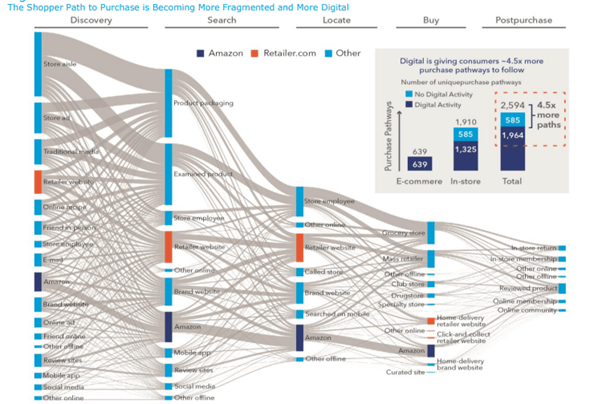
Source: IRI
If you’re curious, read more about the CPG Industry, consumers, supply chain, and beyond.
As highlighted above, evolution in Sales and Marketing is influencing purchase decisions as traditional approaches give way to modern strategies, consumers are experiencing a shift in how products and services are promoted and presented.
With the help of CPG data insights, Traditionally in CPG space, consumer demands for essential products were predictable. Let us say in 2001 a Walmart store in Suburbs of Kansas City was selling two hundred boxes of a particular Cereal brand a month. The variability in that demand was low and forecasts could be reasonably accurate. For an average monthly demand of two hundred boxes, the demand might be 160 in January or may get to 250 in July.
In 2023, that demand can now vary dramatically – sometime over a span of few days. One viral social media post for the said brand could bring down the demand to twenty boxes or can make it go past 1,000 boxes. This variation does not always have to be on a national scale.
Social Media posts can trend locally, nationally or may go global. If a customer has a wonderful experience with a particular product, a simple post in a local community WhatsApp group might increase the purchase dramatically at a specific store. A post from a local celebrity might influence sales across all stores in a whole city or a nationally viral post can impact sales, positively or negatively, across the board.
Such variation was very uncommon a few years back. Using CPG data analysis to deal with this volatility is a problem that category managers, retailers, marketers, sales staff, planners, and production staff are all dealing with day in and day out.
Thankfully, technology has advanced to a point where we can utilize various cloud-based AI technologies to analyze and understand these shifts. By leveraging these CPG retail analytics solutions, we can closely examine changes in consumer behavior, purchase patterns, and industry trends. This enables us to make informed decisions and adapt our strategies effectively addressing the dynamic nature of the market.
In 2022, the global cloud computing market for the CPG industry was valued at $12.6 billion and is expected to reach $25.4 billion by 2027, growing at a CAGR of 11.6%.
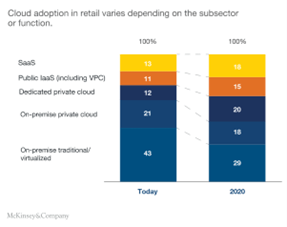
Source: McKinsey&Company
The emergence of cloud technologies and subsequently SaaS platforms has exposed an enormous amount of data for organizational consumption. Data points that were previously hidden behind several layers of technical designs of ERP systems or spread across lockers of various IT systems became readily available for most business users. Access to such an enormous size of data led to explosive growth in all types of Analytics space.
Business users, suppliers, finance teams, supply chain teams, Sales teams, Marketing teams, and HR – all different functions got data access.
Various versions of metrics, dashboards, and reports started to be churned out by users. This data can be overwhelming for the best of the companies and especially for consumer goods space where the emergence of Omni channel commerce has dramatically increased the complexity of marketing, sales, and supply chain operations.
Moreover, the multi-tiered distribution channel for CPG – like from brand to distributor to retailer to consumer adds significant lag in access to relevant data.
But now the question is - how CPG analytics aids brands in analysing consumer changes, ultimately driving growth and innovation.
“Building an effective Analytics function is a journey and not a destination”.
Siddharth Poddar Industry Head - CPG Polestar Analytics
Siddharth Poddar, CPG leader and Industry head at Polestar Analytics mentioned the transformative potential of CPG Data Analytics and highlighted the role of business intelligence and CPG analytics tool accessibility in shaping the adoption journey of analytics.
Game-Changing Business Intelligence Approach
To embark on the journey of leveraging CPG data insights, business leaders must expand their thinking beyond individual departments such as sales, marketing, operations, procurement, and finance.
While Business Intelligence for these functions has become common place, CPG analytics companies can gain a holistic view of their business performance, identify areas for improvement, monitor market trends, and assess the effectiveness of marketing campaigns. It enables them to track key performance indicators (KPIs), measure the success of product launches, identify consumer preferences, and optimize pricing and promotional strategies through:
Accessibility to CPG Analytics tools
The second key step that can be taken is simplifying access for business users to this decision-making tool. Business users may end up getting lost in this euphoria of data and CPG analytics use cases. For some data enthusiasts may be able to find their footing comfortably. For an average user, the multiple reports, similar-looking dashboards, and metrics may be overwhelming and deter them from leveraging data to drive better decisions.
Then, how to approach it?
It is imperative for analytics leaders to assist users in adopting analytics in a systemic manner. Focusing on basics first, followed by more complex and making their way into CPG analytics use cases use cases. It may be better to invest time in maturing ten analytics use cases that influence decision-making rather than to have one hundred that are open-ended.
The individual journey for each organization will be different depending on your starting position and end objectives. Each CPG retail analytics use case goes through a maturity life cycle starting from basic data gathering and evolving into predictive analytics in Consumer Packaged Goods industry.
For example, a spend analysis maturity can look like this:
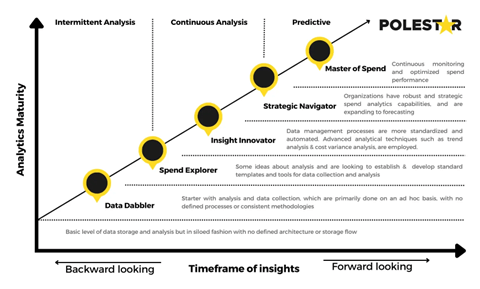
Source: Spend Analysis Guide
Suggesting all CPG analytics companies to introspect, find the analytics use cases that most appeal to them, and work towards building a data analytics engine that works for their business users.
CPG analytics companies play a pivotal role in providing insights and data-driven solutions for businesses in the consumer goods industry. Some prominent CPG data analytics companies include Nielsen, Kantar, Edge by Ascential etc.
After reading this don't settle for ordinary results. Unlock the power of CPG Analytics tools business. Visit our website to get started!
Bravo! You’ve made it till here. Now, you have a solid grasp of the ever-changing landscape of consumer awareness and demands. From volatile purchase decisions to accessibility and social media trends, these factors drive the dynamics of the market.
However, there is one tool that can help CPG companies analyse these changes: Analytics.
If you're unsure about how to embrace analytics for your CPG company, look no further. At Polestar Analytics, we offer Discovery workshops for CPG analytics consulting designed to review and assess the requirements and current state of your analytics infrastructure followed by a discussion on the understanding of vision (where you want to be) and areas of improvement. Request a free consultation today!
About Author

Marketing Consultant
Data Alchemy can give decision making the golden touch.